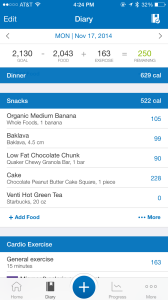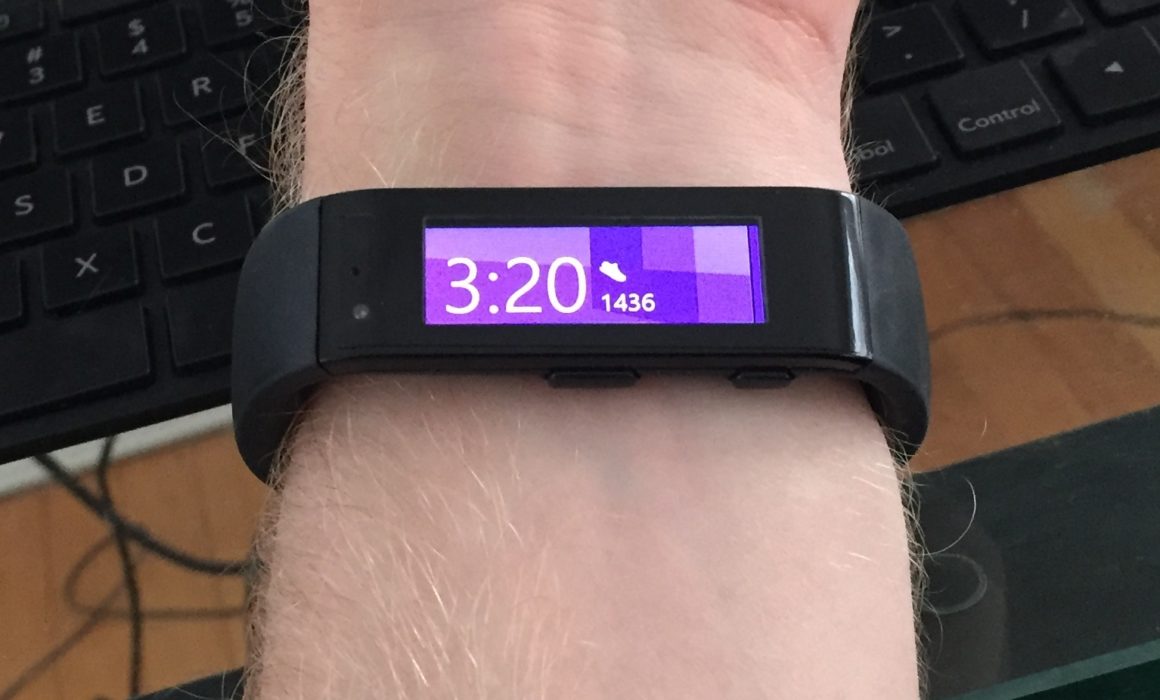Does the Microsoft Band Hold Up to Initial Impressions?: One Week Review
It’s been a little over a week now of daily use with the Microsoft Band, and many of my initial impressions are still holding true.
The biggest criticism that I’ve seen about the Microsoft Band has come from the fit and size of the wearable device. Coming from someone who has never worn a watch or a wrist wearable, I can honestly say that the fit, for the most part, has not bothered me too much. Granted, I don’t have any point of reference, like a standard watch or a Fitbit, to compare that to, but I’ve been wearing the Band pretty much nonstop and I haven’t noticed it much. Every once in a while the sensor on the inside of the band “sticks” a bit to my wrist, and I catch myself shifting the Band’s position or loosening the clasp a bit. This may be enough to put some people off altogether, but it’s usually something I’m not even conscious of. I did have an issue where one of the cuff of my dress shirt was tough to fit around the Band and had to leave the cuffs unbuttoned to accommodate for the extra bulk on my wrist. It’s also difficult to check notifications when the Band is underneath a dress shirt, unless I wore it at the top of my wrist closest to my hand. While the same problem would come with wearing a traditional watch, I don’t suspect smaller wearables, like the Jawbone or Fitbit would have the same issue.
The other main critique in most reviews is battery life. Again, this comes down to what you’re looking for in a device. A lot of fitness wearables will get you 5-7 days of battery life, but with less features, while smartwatches tend to need nightly charging, and gives you more features. I’ve used the Band nonstop since picking it up, and have only received a low battery warning once during that time. I charge it when I’m taking showers and getting ready for work or bed, maybe an hour a day, and it rarely dips below 60%. That said, I haven’t used the built in GPS (it’s been way too cold out recently), which I heard drains the battery much more quickly. The Band charges super fast as well. After receiving the low battery warning, I put the Band on the charger and it was back up to 80% in less than an hour. For my lifestyle, this infrequent charging has worked out great, but if you travel often or you’re looking for a device that you don’t have to worry about charging for days at a time, the Band is probably not for you.
I can’t speak fully on how durable the hardware is, as I have yet to forcefully whack it against anything. Wearing the screen on the inside of your wrist as it is intended makes it much less susceptible to impact. I have hit it on a tabletop or two, but there aren’t any scratches on the device. Microsoft also gives a free screen protector with the Band to help prevent dings and scratches. I did purchase the insurance policy for $20, which replaces the device should anything damage it, which, in my opinion, is a pretty good deal considering it’s meant to be worn while exercising.
A lot of the features and software, including what is still lacking, I already discussed in my initial impressions, so I won’t repeat them here as they still hold true. The only difference is that since purchasing the Band, I picked up an iPhone. Outside of not having access to Cortana, which I found marginally useful anyway, the experience is the same, and I suspect this holds true with Android devices as well.
How has the Band impacted my life?
As I mentioned at the end of my initial impressions, simply the act of having and using a fitness tracker changes the way I go about my day to day life. Having tangible metrics surrounding my health, like the number of calories I’ve burned in a day compared to a daily goal, has prompted me to be a lot more active, whether that is exercising more or just getting up from the computer to roam around every so often. I try to make it to the gym a couple of times a week, but now I have also adopted a quick 7-15 minute workout for my off gym days.

Pairing Microsoft Health with myfitnesspal allows you to track calories consumed and expended throughout the day.
Not only am I tracking how many steps I’ve taken and calories I’ve burned, but being able to track sleep has made me think much differently about my daily habits, although it would still be super useful for the Microsoft Health app to make recommendations rather than me guessing about how to make improvements.
Maybe it’s the nerd in me, but this experience of tracking steps, calories, and sleep has also inspired me to start collecting as many data points on my life as I can.
I paired the Microsoft Health app with the myfitnesspal app, which allows you to track how many calories you eat. While this may not be 100% accurate as it’s hard to sometimes judge serving sizes (I’m not at the point where I’m measuring out how many cups of cereal I eat in the morning) and calories in homemade meals, the built in bar scanner lets me take a pretty good stab at it. The calories you burn in working out are automatically input into the myfitnesspal app, so you can get an overall picture of daily net calories. The app also helps you with goal setting and weight tracking as well. I would love to see more of these partnerships as Microsoft Health grows. Unrelated to health, I’ve also started tracking how I utilize my time throughout the day to see when I’m most/least productive. While the Band doesn’t help me with this specifically, the metrics surrounding the Band has inspired me to make universal changes in my life.
Aside from health benefits, having notifications on my wrist has drastically reduced the number of times I check my phone while I’m driving. Since I drive with my hand on the top of the wheel, it’s much safer and quicker for me just to glance down at my wrist then to pick up and look at my phone. In fact, this is the only time I wear the screen on the outside of my wrist, as trying to read a horizontal screen without being a contortionist is extremely difficult. Since I have an obsessive compulsive need to check notifications as soon as I get them, I find it to be a lot less obtrusive to glance at my wrist than whip out my phone while I’m in a conversation with someone, although some people might find both actions to be rude anyway.
Conclusion – Should you buy the Band?
I stand by my initial conclusions as to who the Band is right for, and who is better off picking up a different fitness tracker or smartwatch.
If you’re not currently using some kind of fitness tracker, do yourself a favor and pick one up.
While some people might not want to get into all of the data heavy tracking that I did, it would be hard for me to believe that by using one, you won’t see some kind of positive impact in your health. The Band may be too much or too little for your specific use, and there are plenty of options available now and upcoming in the near future to suit everyone’s needs.
The Band (and other fitness wearables for that matter) would make a great holiday gift for everyone from casual gym goers to fitness enthusiasts to those wanting to start exercising more – providing you can find one in stock. From what I hear, the Band is still in short supply (at the time of writing, the online Microsoft Store didn’t have any size available to purchase and my local retail store were still backordered). Don’t spend more than the retail $200, as I believe that’s the sweet spot for this device.
Most of us can stand to live healthier lives, and fitness tracking devices are a great way to receive some meaningful feedback to allow us to make positive changes. The Microsoft Band isn’t right for everyone, and there are still many improvements that can be made, but it is a solid device with a range of features that can go a long way into making an impact on your daily health.
[tribulant_slideshow gallery_id=”2″]


